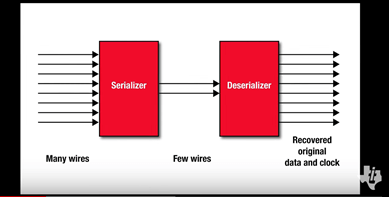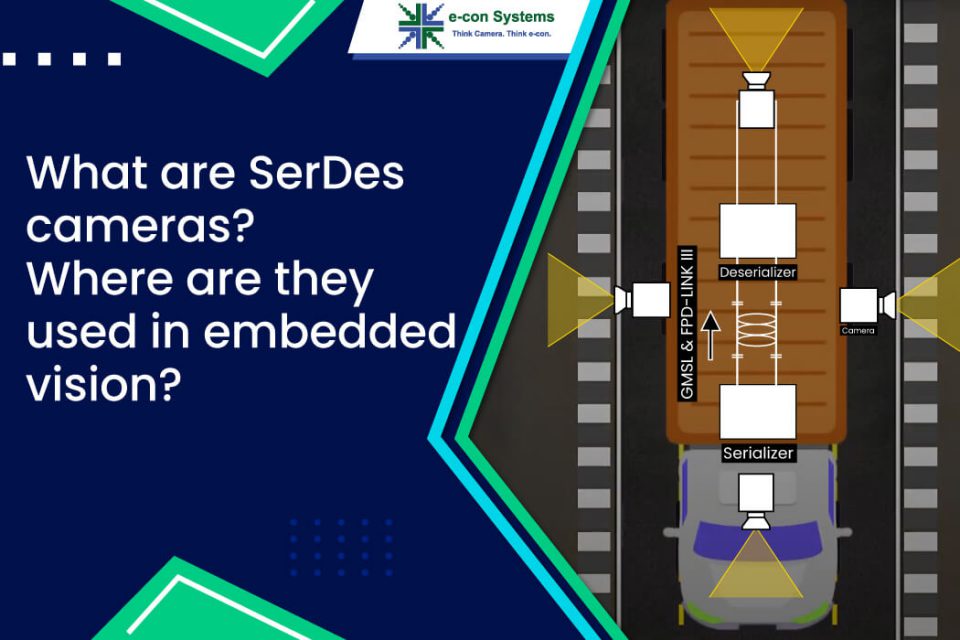With the proliferation of mobile phones and autonomous (and semi-autonomous) cars & vehicles, the adoption of cameras has been on the rise in the last 5 to 10 years. As processing technology also advanced significantly, high-end embedded vision cameras were developed to leverage edge AI capabilities – of processing platforms – in modern embedded devices like robots, smart traffic systems, autonomous shopping systems, etc.
These systems rely on high-quality image and video data for machine learning and deep learning algorithms – that are run on the edge – to derive various kinds of inferences and make intelligent decisions. Most of these devices are huge and require a data transmission methodology to transfer large quantum of data over long distances (often in excess of 3 to 5 meters).
And most of the commonly used camera interfaces such as USB, MIPI, GigE, etc., are not sufficient to perform the task. While MIPI and USB lacked the ability to take data – practically – beyond 3 meters, GigE had limitations with respect to bandwidth. This is where the SerDes (Serializer/Deserializer) technique made a difference.
In this blog post, we will learn what SerDes cameras are, their working principle, different types, and some of the key embedded vision applications where they are used.
Understanding the SerDes methodology
Ordinary camera interfaces transfer data by connecting directly from the camera to the host or the SoC (System on Chip). As mentioned before, this posed challenges with respect to bandwidth and distance of transmission.
On the other hand, the SerDes technique uses the combination of a serializer and a deserializer to enable the transmission of pixel streams from the camera as serial bit streams. It is the serializer that converts the image and the control data into serial bits, while the deserializer at the host’s end converts the serial bits back to pixel data. The transmission of data is done smoothly using a coaxial or STP (Shielded Twisted Pair) cable.
The following figure illustrates the architecture of a SerDes transmission system:
 Figure 1 – architecture of a SerDes system (source: Texas Instruments)
Figure 1 – architecture of a SerDes system (source: Texas Instruments)
One of the advantages of a SerDes interface is that it can transfer the control data as well in addition to the video data. This makes the process of camera synchronization seamless.
Some of the other advantages of the SerDes method of data transmission include:
- Enables high-bandwidth long-distance transmission up to a maximum of 25 meters (most interfaces go up to 15 meters. However, there are some like GMSL1 that can transmit data to 25 meters).
- Designed for the automotive industry, it meets all the necessary quality standards for any form of industrial use – making the interface and the cable resistant to shock, vibration, temperature variations, etc.
- SerDes interfaces offer a transfer rate in excess of 3.5 Gbps (some can go up to 10) which makes them suitable for even the most modern embedded vision applications.
Popular SerDes camera interfaces
Two companies that have pioneered the SerDes technique are Texas Instruments (TI) and Maxim Integrated. While TI offers the FPD-Link (Flat Panel Display Link) family of SerDes interfaces, Maxim designs and sells the GMSL (Gigabit Multimedia Serial Link) series of interfaces. In this section, let us learn more about the two.
FPD-Link (Flat Panel Display Link)
FPD-Link is a SerDes technique developed by TI. The latest among the family of FPD-Link interfaces is FPD-Link III. It is a long-distance camera interface that can transfer both video and control data up to a distance of 15 meters. The interface is highly optimized for ADAS (Advanced Driver Assistance Systems). TI also positions it for security & surveillance cameras, industrial systems, and medical imaging.
Owing to its performance with respect to long-distance transmission and the ability to operate in harsh external conditions, FPD-Link III cameras can be used in embedded vision applications such as:
- Autonomous mobile robots
- Agricultural vehicles and tractors
- Self-checkout systems
- Intelligent Video Analytics (IVA)
- Trucks and vehicles
You can learn more about the technical features of FPD-Link III here.
GMSL (Gigabit Multimedia Serial Link)
GMSL is a series of SerDes interfaces from Maxim Integrated. It includes the first-generation (GMSL1), second-generation (GMSL2), and third-generation (GMSL3) interfaces, of which GMSL3 is the most advanced one in terms of performance. However, it might be an overkill, and GMSL2 is sufficient for most modern camera-based applications.
GMSL2 (the most widely adopted of the three generations as of today) has been positioned as an interface for the automotive sector. However, as in the case of FPD Link III, GMSL2 cameras can be used in most of the embedded vision applications where (high-bandwidth) long-distance transmission is required – such as robots, autonomous vehicles, large trucks, mining vehicles, autonomous shopping systems, etc.
GMSL2 cameras vs. FPD-Link III cameras
GMSL2 and FPD-Link III are comparable interfaces when it comes to their features. At the same time, there are some minor differences at a performance level.
Feature comparison of GMSL2 and FPD-Link III:
| FEATURE/PARAMETER | FPD-LINK III | GMSL2 |
| Backward Interface | I2C | I2C & UART |
| Forward Interface | 4 lane MIPI CSI 2 | MIPI & Parallel interface |
| Package Size | 5mm x 5mm | 7mm x 7mm |
| Operating Temperature | –40°C to +125°C | –40°C to +125°C |
| Bandwidth for FC & BC | 4.16 Gbps & 50 Mbps | 6Gbps & 187Mbps |
| GPIO supported | 4 | 10 |
| Audio transmission | Possible | Not possible |
| Synchronization | Possible | Possible |
| Max. cable length | 15m | 15m |
To learn how the two interfaces compare with each other in detail, check out GMSL2 cameras vs. FPD-Link III cameras – a detailed study.
To learn how GMSL2 cameras compare with MIPI cameras, read GMSL Camera over MIPI Camera.
Embedded vision applications where SerDes cameras are used
We already touched upon a few key applications where GMSL and FPD-Link cameras are used. Here, let us dive a little deeper into some of them.
Autonomous Mobile Robots (AMRs)
AMRs vary from a couple of feet to a few meters in size. Large AMRs need to transmit high-quality images to the host processor with the lowest possible latency for the robot to take real-time decisions. A SerDes camera can serve this imaging need. Both GMSL and FPD-Link cameras can be used in AMRs such as warehouse robots, delivery robots, telepresence robots, agricultural robots, etc.
Features such as long-distance transmission (up to 25m), low latency, resistance to shocks & vibrations, and high transfer rate (up to 10 Gbps) make SerDes cameras suitable for most robotic applications. However, the choice of a particular interface (say GMSL vs. FPD-Link) has to be done based on the particulars of the use case. This is one of the areas where e-con Systems helps its customers in addition to offering camera solutions.
Agricultural vehicles
Agricultural robots (automated weeders, harvesting robots, plowing robots, etc) and tractors are often huge and require the camera to be placed at a distance beyond 5 meters (or more) from the host processor. A SerDes camera is perfect for such a use case. Whether it’s for navigation, crop monitoring, or measuring NDVI (Normalized Difference Vegetation Index), a GMSL or FPD-Link camera with the right features can enable agricultural vehicles to perform their desired tasks.
Autonomous shopping systems
Camera-enabled autonomous shopping systems typically come in three variants:
- Smart trolley systems
- Self-checkout systems
- Devices with roof-mounted cameras
Depending on the architecture of these devices, a long-distance camera might be required in all of them. While GigE cameras can be an option, they come with bandwidth limitations. Hence SerDes cameras are a perfect choice for autonomous shopping systems.
Intelligent Video Analytics (IVA)
IVA applications involve analyzing the captured image and video data to derive certain inferences. For instance, consider a smart traffic device that is used to count the number of vehicles and pedestrians in a junction. Cameras in such a device are often placed at the top of a pole with the host processor at the bottom of (not always, but in most cases).
This necessitates the need for long-distance transmission. In addition, some of the complex smart traffic devices might require the system to identify passengers or drivers inside a moving vehicle. This in turn requires the system to run sophisticated AI (Artificial Intelligence) and ML (Machine Learning) algorithms for inferencing purposes. Beyond doubt, a SerDes camera perfectly fits here.
Similarly, other IVA applications like smart surveillance and parking lot management can also find SerDes cameras to be an ideal solution.
Trucks and vehicles
For the same reasons as in the case of the other applications, GMSL and FPD Link cameras can be used in vehicles such as trucks, mining vehicles, automated forklifts, etc.
That covers everything about the fundamentals of SerDes cameras. If you have any queries about the topic, please do leave a comment.
As always, if you are interested in integrating new-age SerDes (and other types of) cameras into your system, you know where to go. Please write to us at camerasolutions@e-consystems.com, and we will make sure to respond at the earliest. Meanwhile, please feel free to check out the Camera Selector to have a look at our complete portfolio of products.
SerDes cameras by e-con Systems®
e-con systems has been designing, developing, and manufacturing OEM camera solutions since 2003. Our GMSL cameras use GMSL, GMSL2 & GMSL3 technology to operate at full speed with minimal latency and high frame rates.
Our latest GMSL2 camera, STURDeCAM34, is a 3MP GMSL2™ camera module based on the AR0341AT CMOS image sensor. It features advanced super-exposure pixel technology, offering up to 140 dB High Dynamic Range (HDR) with LED Flicker Mitigation (LFM) capabilities. The STURDeCAM34 cameras also features an on-board high-performance ISP, delivering enhanced image processing for superior clarity.
One of its standout features is e-con Systems’ patented hot-pluggable GMSL support, allowing you to connect or disconnect the camera without causing system downtime or disruptions.
STURDeCAM34 is an ideal choice for Advanced Driver Assistance Systems (ADAS) and other mission-critical applications requiring reliable, high-quality imaging solutions.
Explore our FPD-Link III cameras
Use our Camera Selector to look at our complete portfolio of products.
If you need help integrating new-age SerDes (and other types of) cameras into your system, please write to camerasolutions@e-consystems.com.

Prabu is the Chief Technology Officer and Head of Camera Products at e-con Systems, and comes with a rich experience of more than 15 years in the embedded vision space. He brings to the table a deep knowledge in USB cameras, embedded vision cameras, vision algorithms and FPGAs. He has built 50+ camera solutions spanning various domains such as medical, industrial, agriculture, retail, biometrics, and more. He also comes with expertise in device driver development and BSP development. Currently, Prabu’s focus is to build smart camera solutions that power new age AI based applications.




